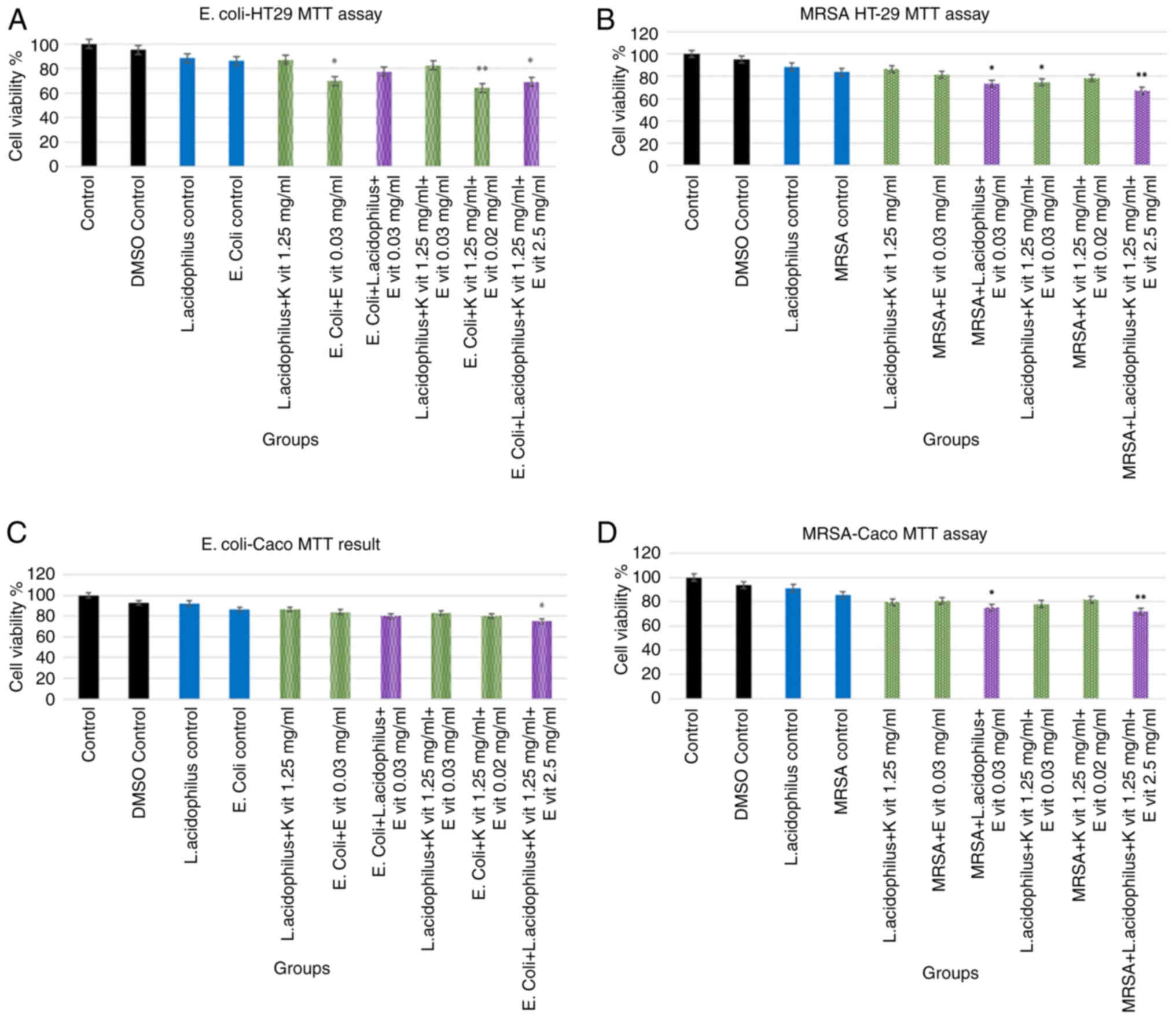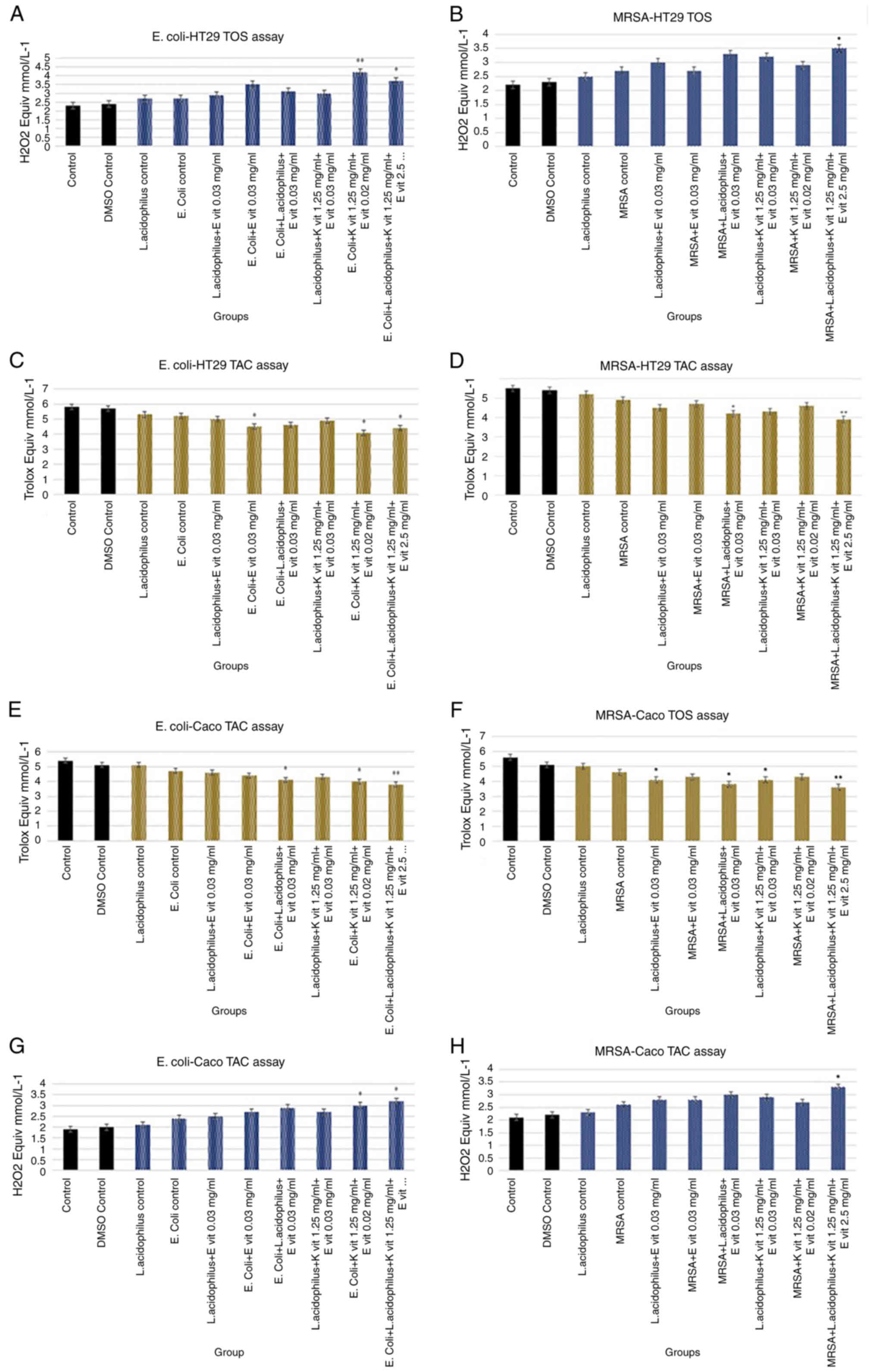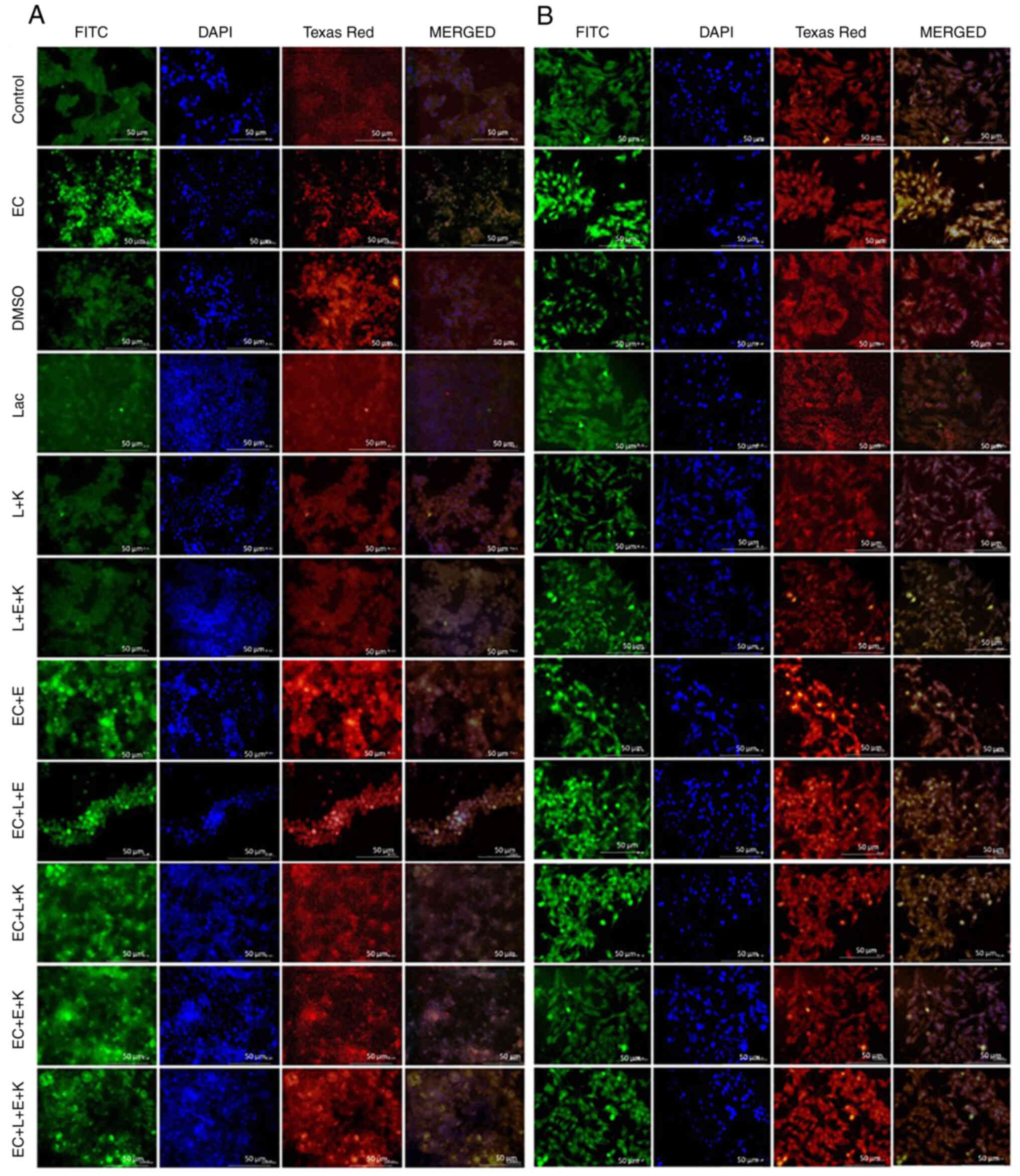|
1
|
Caputi V and Giron MC:
Microbiome-gut-brain axis and toll-like receptors in Parkinson's
disease. Int J Mol Sci. 19:16892018. View Article : Google Scholar : PubMed/NCBI
|
|
2
|
Rea D, Coppola G, Palma G, Barbieri A,
Luciano A, Del Prete P, Rossetti S, Berretta M, Facchini G, Perdonà
S, et al: Microbiota effects on cancer: From risks to therapies.
Oncotarget. 9:17915–17927. 2018. View Article : Google Scholar : PubMed/NCBI
|
|
3
|
Selber-Hnatiw S, Rukundo B, Ahmadi M,
Akoubi H, Al-Bizri H, Aliu AF, Ambeaghen TU, Avetisyan L, Bahar I,
Baird A, et al: Human gut microbiota: Toward an ecology of disease.
Front Microbiol. 8:12652017. View Article : Google Scholar : PubMed/NCBI
|
|
4
|
Rajagopala SV, Vashee S, Oldfield LM,
Suzuki Y, Venter JC, Telenti A and Nelson KE: The human microbiome
and cancer. Cancer Prev Res (Phila). 10:226–234. 2017. View Article : Google Scholar : PubMed/NCBI
|
|
5
|
Saud Hussein A, Ibraheem Salih N and
Hashim Saadoon I: Effect of Microbiota in the development of breast
cancer. Arch Razi Inst. 76:761–768. 2021.PubMed/NCBI
|
|
6
|
Kwak YK, Vikström E, Magnusson KE, Vécsey
Semjén B, Colque Navarro P and Möllby R: The Staphylococcus aureus
alpha-toxin perturbs the barrier function in Caco-2 epithelial cell
monolayers by altering junctional integrity. Infect. Immun.
80:1670–1680. 2012.PubMed/NCBI
|
|
7
|
Boyce JM and Havill NL: Nosocomial
antibiotic-associated diarrhea associated with
enterotoxin-producing strains of methicillin-resistant
Staphylococcus aureus. Am J Gastroenterol. 100:1828–1834. 2005.
View Article : Google Scholar : PubMed/NCBI
|
|
8
|
Lu J, Wang A, Ansari S, Hershberg RM and
McKay DM: Colonic bacterial superantigens evoke an inflammatory
response and exaggerate disease in mice recovering from colitis.
Gastroenterology. 125:1785–1795. 2003. View Article : Google Scholar : PubMed/NCBI
|
|
9
|
Salyers AA, Gupta A and Wang Y: Human
intestinal bacteria as reservoirs for antibiotic resistance genes.
Trends Microbiol. 12:412–416. 2004. View Article : Google Scholar : PubMed/NCBI
|
|
10
|
Sommer MOA, Dantas G and Church GM:
Functional characterization of the antibiotic resistance reservoir
in the human microflora. Science. 325:1128–1131. 2009. View Article : Google Scholar : PubMed/NCBI
|
|
11
|
Rimland D and Roberson B: Gastrointestinal
carriage of methicillin-resistant Staphylococcus aureus. J Clin
Microbiol. 24:137–138. 1986. View Article : Google Scholar : PubMed/NCBI
|
|
12
|
Donskey CJ: the role of the intestinal
tract as a reservoir and source for transmission of nosocomial
pathogens. Clin Infect Dis. 39:219–226. 2004. View Article : Google Scholar : PubMed/NCBI
|
|
13
|
Ray AJ, Pultz NJ, Bhalla A, Aron DC and
Donskey CJ: Coexistence of vancomycin-resistant enterococci and
Staphylococcus aureus in the intestinal tracts of hospitalized
patients. Clin Infect Dis. 37:875–881. 2003. View Article : Google Scholar : PubMed/NCBI
|
|
14
|
Blount ZD: The unexhausted potential of
E. coli. Elife. 4:e058262015. View Article : Google Scholar : PubMed/NCBI
|
|
15
|
Jang SE, Lim SM, Jeong JJ, Jang HM, Lee
HJ, Han MJ and Kim DH: Gastrointestinal inflammation by gut
microbiota disturbance induces memory impairment in mice. Mucosal
Immunol. 11:369–379. 2018. View Article : Google Scholar : PubMed/NCBI
|
|
16
|
Fu M, Liang S, Wu J, Hua Y, Chen H, Zhang
Z, Liu J, Li X, Zhang B, Zhao W and Wan C: An Escherichia coli
Effector Protein EspF May Induce Host DNA damage via interaction
with SMC1. Front Microbiol. 12:6820642021. View Article : Google Scholar : PubMed/NCBI
|
|
17
|
Wan R, Mo Y, Zhang Z, Jiang M, Tang S and
Zhang Q: Cobalt nanoparticles induce lung injury, DNA damage and
mutations in mice. Part Fibre Toxicol. 14:382017. View Article : Google Scholar : PubMed/NCBI
|
|
18
|
Fu MH, Chen IC, Lee CH, Wu CW, Lee YC,
Kung YC, Hung CY and Wu KLH: Anti-neuroinflammation ameliorates
systemic inflammation-induced mitochondrial DNA impairment in the
nucleus of the solitary tract and cardiovascular reflex
dysfunction. J Neuroinflammation. 16:2242019. View Article : Google Scholar : PubMed/NCBI
|
|
19
|
Candela M, Perna F, Carnevali P, Vitali B,
Ciati R, Gionchetti P, Rizzello F, Campieri M and Brigidi P:
Interaction of probiotic Lactobacillus and Bifidobacterium strains
with human intestinal epithelial cells: Adhesion properties,
competition against enteropathogens and modulation of IL-8
production. Int J Food Microbiol. 125:286–292. 2008. View Article : Google Scholar : PubMed/NCBI
|
|
20
|
Fayol-Messaoudi D, Berger CN,
Coconnier-Polter MH, Lievin Le Moal V and Servin AL: pH-, lactic
acid-, and nonlactic acid-dependent activities of probiotic
lactobacilli against Salmonella enterica Serovar Typhimurium. Appl
Environ Microbiol. 71:6008–6013. 2005. View Article : Google Scholar : PubMed/NCBI
|
|
21
|
Kim Y, Kim SH, Whang KY, Kim YJ and Oh S:
Inhibition of Escherichia coli O157:H7 attachment by interactions
between lactic acid bacteria and intestinal epithelial cells. J
Microbiol Biotechnol. 18:1278–1285. 2008.PubMed/NCBI
|
|
22
|
Mappley LJ, Tchorzewska MA, Cooley WA,
Woodward MJ and La Ragione RM: Lactobacilli antagonize the growth,
motility, and adherence of Brachyspira pilosicoli: A potential
intervention against avian intestinal spirochetosis. Appl Environ
Microbiol. 77:5402–5411. 2011. View Article : Google Scholar : PubMed/NCBI
|
|
23
|
Varma P, Dinesh KR, Menon KK and Biswas R:
Lactobacillus fermentum isolated from human colonic mucosal biopsy
inhibits the growth and adhesion of enteric and foodborne
pathogens. J Food Sci. 75:M546–M551. 2010. View Article : Google Scholar : PubMed/NCBI
|
|
24
|
Zhang YC, Zhang LW, Tuo YF, Guo CF, Yi HX,
Li JY, Han X and Du M: Inhibition of Shigella sonnei adherence to
HT-29 cells by lactobacilli from Chinese fermented food and
preliminary characterization of S-layer protein involvement. Res
Microbiol. 161:667–672. 2010. View Article : Google Scholar : PubMed/NCBI
|
|
25
|
Horwıtt MK: Interpretations of
requirements for thiamin, riboflavin, niacin tryptophan, and
vitamin E plus comments on balance studies and vitamin B-6. Am J
Clin Nutr. 44:973–985. 1986. View Article : Google Scholar : PubMed/NCBI
|
|
26
|
Andrade JC, Morais Braga MF, Guedes GM,
Tintino SR, Freitas MA, Quintans LJ Jr, Menezes IR and Coutinho HD:
Menadione (vitamin K) enhances the antibiotic activity of drugs by
cell membrane permeabilization mechanism. Saudi J Biol Sci.
24:59–64. 2017. View Article : Google Scholar : PubMed/NCBI
|
|
27
|
Balimane PV, Chong S and Morrison RA:
Current methodologies used for evaluation of intestinal
permeability and absorption. J Pharmacol. Toxicol Methods.
44:301–312. 2000. View Article : Google Scholar : PubMed/NCBI
|
|
28
|
Blanchfield JT, Dutton JL, Hogg RC,
Gallagher OP, Craik DJ, Jones A, Adams DJ, Lewis RJ, Alewood PF and
Toth I: Synthesis, structure elucidation, in vitro biological
activity, toxicity, and Caco-2 cell permeability of lipophilic
analogs of r-Conotoxin MII. J Med Chem. 46:1266–1272. 2003.
View Article : Google Scholar : PubMed/NCBI
|
|
29
|
Genc S, Pennisi M, Yeni Y, Yildirim S,
Gattuso G, Altinoz MA, Taghizadehghalehjoughi A, Bolat I, Tsatsakis
A, Hacımüftüoğlu A and Falzone L: Potential neurotoxic effects of
glioblastoma-derived exosomes in primary cultures of cerebellar
neurons via oxidant stress and glutathione depletion. Antioxidants
(Basel). 11:12252022. View Article : Google Scholar : PubMed/NCBI
|
|
30
|
Rogero SO, Higa OZ, Saiki M, Correa OV and
Costa I: Cytotoxicity due to corrosion of ear piercing studs.
Toxicol In Vitro. 14:497–504. 2000. View Article : Google Scholar : PubMed/NCBI
|
|
31
|
National Committee for Clinical Laboratory
Standards (NCCLS), Performance standards for antimicrobial disk
susceptibility tests, . Approved standard. NCCLS document M2-A5.
NCCLS; Villanova, PA: pp. 138–144. 1993
|
|
32
|
Ackermann G, Thomalla S, Ackermann F,
Schaumann R, Rodloff AC and Ruf BR: Prevalence and characteristics
of bacteria and host factors in an outbreak situation of
antibiotic-associated diarrhea. J Med Microbiol. 54:149–153. 2005.
View Article : Google Scholar : PubMed/NCBI
|
|
33
|
Celebi D, Taghizadehghalehjoughi A, Baser
S, Genc S, Yilmaz A, Yeni Y, Yesilyurt F, Yildirim S, Bolat I,
Kordali S, et al: Effects of boric acid and potassium metaborate on
cytokine levels and redox stress parameters in a wound model
infected with methicillin-resistant Staphylococcus aureus. Mol Med
Rep. 26:2942022. View Article : Google Scholar : PubMed/NCBI
|
|
34
|
Le Gall T, Clermont O, Gouriou S, Picard
B, Nassif X, Denamur E and Tenaillon O: Extraintestinal virulence
is a coincidental by-product of commensalism in B2 phylogenetic
group Escherichia coli strains. Mol Biol Evol. 24:2373–2384. 2007.
View Article : Google Scholar : PubMed/NCBI
|
|
35
|
Zuccotti GV, Meneghin F, Raimondi C,
Dilillo D, Agostoni C, Riva E and Giovannini M: Probiotics in
clinical practice: An overview. J Int Med Res. 36 (Suppl 1):1A–53A.
2008. View Article : Google Scholar : PubMed/NCBI
|
|
36
|
Ghane M, Babaeekhou L and Ketabi SS:
Antibiofilm activity of kefir probiotic lactobacilli against
uropathogenic Escherichia coli (UPEC). Avicenna J Med Biotechnol.
12:221–229. 2020.PubMed/NCBI
|
|
37
|
Salminen S and Von Wright A: Lactic acid
bacteria: Microbiological and functional aspects. CRC Press; pp.
p6562004
|
|
38
|
Kumara SS, Bashisht A, Venkateswaran G,
Hariprasad P and Gayathri D: Characterization of novel
lactobacillus fermentum from curd samples of indigenous cows from
malnad region, Karnataka, for their aflatoxin B1 binding and
probiotic properties. Probiotics Antimicrob Proteins. 11:1100–1109.
2019. View Article : Google Scholar : PubMed/NCBI
|
|
39
|
Vasudha M and Gayathri D: Kinetic and
modeling analyses of lactose-hydrolyzing β-galactosidase from
Lactiplantibacillus plantarum GV54. World Academy Sci J. 5:112023.
View Article : Google Scholar
|
|
40
|
Vasudha M, Prashantkumar CS, Bellurkar M,
Kaveeshwar V and Gayathri D: Probiotic potential of
β-galactosidase-producing lactic acid bacteria from fermented milk
and their molecular characterization. Biomed Rep. 18:232023.
View Article : Google Scholar : PubMed/NCBI
|
|
41
|
Rashmi BS, Gayathri D, Vasudha M,
Prashantkumar CS, Swamy CT, Sunil KS, Somaraja PK and Prakash P:
Gluten hydrolyzing activity of Bacillus spp isolated from
sourdough. Microb Cell Fact. 19:1302020. View Article : Google Scholar : PubMed/NCBI
|
|
42
|
Vasiee A, Falah F, Behbahani BA and
Tabatabaee Yazdi F: Probiotic characterization of Pediococcus
strains isolated from Iranian cereal-dairy fermented product:
Interaction with pathogenic bacteria and the enteric cell line
Caco-2. J Biosci Bioeng. 130:471–479. 2020. View Article : Google Scholar : PubMed/NCBI
|
|
43
|
Nantavisai K, Puttikamonkul S, Chotelersak
K and Taweechotipatr M: In vitro adhesion property and competition
against enteropathogens of Lactobacillus strains isolated from Thai
infants. Songklanakarin J Sci Technol. 40:69–74. 2018.
|
|
44
|
Schillinger U, Guigas C and Holzapfel WH:
In vitro adherence and other properties of lactobacilli used in
probiotic yoghurt-like products. Int Dairy J. 15:1289–1297. 2005.
View Article : Google Scholar
|
|
45
|
Lim SM and Ahn DH: Factors affecting
adhesion of lactic acid bacteria to Caco-2 cells and inhibitory
effect on infection of Salmonella typhimurium. J Microbiol
Biotechnol. 22:1731–1719. 2012. View Article : Google Scholar : PubMed/NCBI
|
|
46
|
Zommiti M, Bouffartigues E, Maillot O,
Barreau M, Szunerits S, Sebei K, Feuilloley M, Connil N and
Ferchichi M: In vitro assessment of the probiotic properties and
bacteriocinogenic potential of Pediococcus pentosaceus MZF16
isolated from artisanal Tunisian meat ‘Dried Ossban’. Front
Microbiol. 9:26072018. View Article : Google Scholar : PubMed/NCBI
|
|
47
|
Vasiee A, Behbahani BA, Tabatabaei Yazdi
F, Mortazavi SA and Noorbakhsh H: Diversity and probiotic potential
of lactic acid bacteria isolated from horreh, a traditional Iranian
fermented food. Probiotics Antimicrob. Proteins. 10:258–268.
2018.
|
|
48
|
Aslim B, Onal D and Beyatli Y: Factors
influencing autoaggregation and aggregation of Lactobacillus
delbrueckii subsp. bulgaricus isolated from handmade yoğurt. J Food
Prot. 70:223–227. 2007. View Article : Google Scholar : PubMed/NCBI
|
|
49
|
Khan AA and Cash P: E. coli and colon
cancer: Is mutY a culprit? Cancer Lett. 341:127–131. 2013.
View Article : Google Scholar : PubMed/NCBI
|
|
50
|
Terzić J, Grivennikov S, Karin E and Karin
M: Inflammation and colon cancer. Gastroenterology.
138:2101–2114.e5. 2010. View Article : Google Scholar : PubMed/NCBI
|
|
51
|
Chattopadhyay I, Dhar R, Pethusamy K,
Seethy A, Srivastava T, Sah R, Sharma J and Karmakar S: Exploring
the role of gut microbiome in colon cancer. Appl Biochem
Biotechnol. 193:1780–1799. 2021. View Article : Google Scholar : PubMed/NCBI
|
|
52
|
Licznerska K, Nejman-Faleńczyk B, Bloch S,
Dydecka A, Topka G, Gąsior T, Węgrzyn A and Węgrzyn G: Oxidative
stress in shiga toxin production by Enterohemorrhagic Escherichia
coli. Oxid Med Cell Longev. 2016:35783682016. View Article : Google Scholar : PubMed/NCBI
|
|
53
|
Xin J, Jiang X, Ben S, Yuan Q, Su L, Zhang
Z, Christiani DC, Du M and Wang M: Association between circulating
vitamin E and ten common cancers: Evidence from large-scale
Mendelian randomization analysis and a longitudinal cohort study.
BMC Med. 20:1682022. View Article : Google Scholar : PubMed/NCBI
|
|
54
|
Choi Y, Lee S, Kim S, Lee J, Ha J, Oh H,
Lee Y, Kim Y and Yoon Y: Vitamin E (α-tocopherol) consumption
influences gut microbiota composition. Int J Food Sci Nutr.
71:221–225. 2020. View Article : Google Scholar : PubMed/NCBI
|
|
55
|
Yang C, Zhao Y, Im S, Nakatsu C,
Jones-Hall Y and Jiang Q: Vitamin E delta-tocotrienol and
metabolite 13′-carboxychromanol inhibit colitis-associated colon
tumorigenesis and modulate gut microbiota in mice. J Nutr Biochem.
89:1085672021. View Article : Google Scholar : PubMed/NCBI
|


















